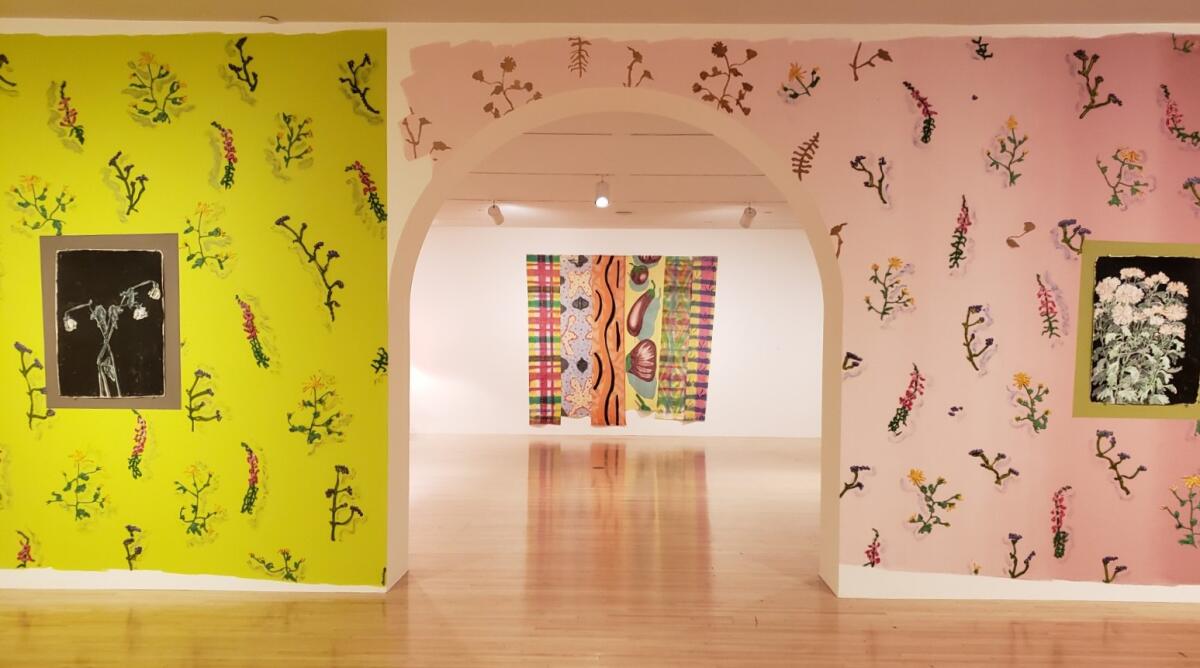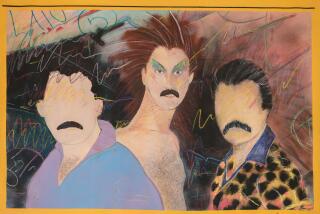Review: More is more. Why the ‘Pattern and Decoration’ show at MOCA is pure pleasure
For most of the last four decades, Pattern and Decoration art seemed wonderfully outré to many observers, an eccentric violation of the standards and norms of serious painting and sculpture that was itself not to be taken too seriously.
P&D, as 1970s Pattern and Decoration was soon called, poked a well-placed finger — or three — in the eye of Minimal art’s crisp reduction of austere forms, the sharp idea-orientation of Conceptual art and the fashionable but still critically iffy appeal of Pop art. All those florid fabric swatches, proliferating curlicues, Moorish arabesques, celebrations of Grandma’s wallpaper and crystal doorknobs, bright colors, polka dots and plaids were all just — well, just too much.
Liking P&D was OK — but only if the fondness registered as a guilty pleasure, preferably accompanied by mild but self-conscious embarrassment. (“I know better; really, I do.”) Soon enough, the movement disappeared into the sandstorm kicked up by loudly marketed Neo-Expressionist painting. By the time the 1980s had come and gone, P&D had too.
Somewhere early on in “With Pleasure: Pattern and Decoration in American Art, 1972-1985,” the large — and important — new historical survey exhibition at the Museum of Contemporary Art, it occurred to me that something unexpected happened while we weren’t paying much attention. Without fanfare or warning, P&D no longer looks like a bizarre defilement, breach or disruption of anything at all.

Instead, P&D now just looks like art. Some of it is superlative, some is not; but to dismiss it wholesale is plainly an error in judgment.
The erudite seriousness of the endeavor, which has been there all along, has risen to the surface of the playful, imaginative, often flamboyant paintings and, occasionally, sculptures and documented performances. That the work no longer appears frivolous or out of place is certainly not an indication of the stature the movement now occupies in the history of recent art. P&D holds no such illustrious place.
In fact, MOCA’s is the first full accounting of the movement undertaken by a major museum. It is something of a return to what made the place major in the first place — an institutional willingness to do the big, thematic historical surveys from which others shy away. MOCA has done it for Minimalism, feminist art, Conceptual art and performance; add P&D to the impressive list.
A few other modest shows of this material have cropped up here and there, but the uniqueness of this one, organized by MOCA curator Anna Katz and featuring 100 works by 45 artists, is indication enough of the institutional blind spot in which P&D has long languished. “With Pleasure” instead reveals that the once seemingly oddball positions these artists championed are fundamental to the art being made today.
P&D artists drew and elaborated on myriad artistic sources, appropriating aspects of global practices for their own varied purposes. Twentieth-century modernism was a distinctive cultural form that emerged in the West, but the world — and its art — is larger than that.
Among the wellsprings of untapped visual languages ripe for use were traditional Japanese scrolls (Takako Yamaguchi), Islamic and Talavera pottery (Ralph Bacerra), Southern American garden gates (Valerie Jaudon), Chinese paintings (Brad Davis), Christian altarpieces (Robert Zakanitch), Chinese clip art (Kim MacConnel), genteel ladies’ fans and Valentine candy boxes (Miriam Schapiro), Persian textiles (Robert Kushner), Tibetan thangkas (Faith Ringgold), Baroque architectural fragments (Betty Woodman), Byzantine mosaics (Ned Smyth), African textiles (Howardena Pindell), Mexican tiles (Joyce Kozloff) and much more. Just about any ornamental art you can think of from any culture in world history fed the work.
The Pop part of P&D is pretty obvious, taking its cues from the mass popularity of decorative forms internationally. (Andy Warhol famously said Pop was about “liking things.”) The Minimalist dimension is embedded in the pattern part.
The exhibition highlights a frequent focus on the grid as a structural pattern for diverse compositions. A grid underlies the very different linear banners of unstretched fabric made by Kozloff, replete with abstract shapes like diamonds and six-pointed stars, and by MacConnel, enlivened with purple eggplants and beets.
Amy Goldin, the brilliant critical theorist of P&D, pointed out that pattern is not located in the simple repetition of forms and images. Pattern resides instead within the steady, measured repetition of intervals between those forms and images. The spatial structure accounts for an almost musical feel to much of this work, sometimes straightforward and sometimes contrapuntal.
But if ’70s P&D is in one way the unexpected offspring of a marriage between ’60s Pop and Minimal art, its midwife is Conceptual art. That is spelled out in Tina Girouard’s “Wall’s Wallpaper I,” one of the show’s gems.
Four vertical strips of fussy, pastel floral wallpaper are mounted on a muslin backing 5 feet square. Clematis climbs a trellis, sprays of yellow roses cascade down a crisscross background and more. Adjacent is a framed sheet of graph paper with instructions, carefully handwritten in pencil, explaining how the wallpapers are to be selected, arranged and permanently installed on a wall.
“Wall’s Wallpaper I” is a marvelous sendup of classic geometric wall drawings, complete with their own complex sets of instructions, by Sol LeWitt, a founder of Conceptual art. It raised a vexing question. If the idea (or concept) behind the work is more important than the finished art object, per Conceptual art’s assertion, why not just use Granny’s decorating scheme from the parlor? It’s loaded with sentiment, unruly memory and wit.
Lurking within Girouard’s example is a salient feature of P&D and its awkward history. Domestic materials evoke a traditionally female purview. It is worth noting that women are central to the Pattern and Decoration movement. (Of the 45 artists here, 28 are women.) The grid wasn’t only a mighty structural legacy of the Industrial Revolution — of the layout of the city block and the skyscraper’s steel framework, forms conventionally associated with male labor. The grid is also the foundation of needlepoint embroidery and a basket’s weave.
In a happy case of serendipity, this show’s 1985 end date coincides with the launch of the mature work of Lari Pittman, providing copious backstory to the smashing Pittman retrospective currently across town at the UCLA Hammer Museum. Both owe much to the confluence of liberation movements of the 1960s — African American, feminist, LGBTQ — yielding a political dimension that undercuts efforts to dismiss its gravity.
If there’s a flaw, though, it’s in the surprising omission of two L.A.-based artists. Ironically, both are male.
Beginning in 1974, Peter Alexander began to develop a marvelous series of glitter and collage paintings on unstretched black velvet, which brought Light and Space art into the emerging framework of Pattern and Decoration. A year later, Don Sorenson (1948-1985) started his impossibly complex zigzag paintings, which grabbed the orderly grid by the lapels, injected vivid color and twisted it into eye-dazzling patterns of spatial discontinuity.
Both should have a place in the survey, but the absence of two paintings is far from fatal. “With Pleasure” has a lot to offer. Pattern and Decoration emerges as a relatively brief, highly focused jab to art’s solar plexus. The jolt now is in recognizing just how deep it went and how well it took.
'With Pleasure: Pattern and Decoration in American Art, 1972-1985'
Where: Museum of Contemporary Art, 250 S. Grand Ave., L.A.
When: Through May 11; closed Tuesdays
Admission: $8-$15
Info: (213) 626-6222, www.moca.org
More to Read
The biggest entertainment stories
Get our big stories about Hollywood, film, television, music, arts, culture and more right in your inbox as soon as they publish.
You may occasionally receive promotional content from the Los Angeles Times.







